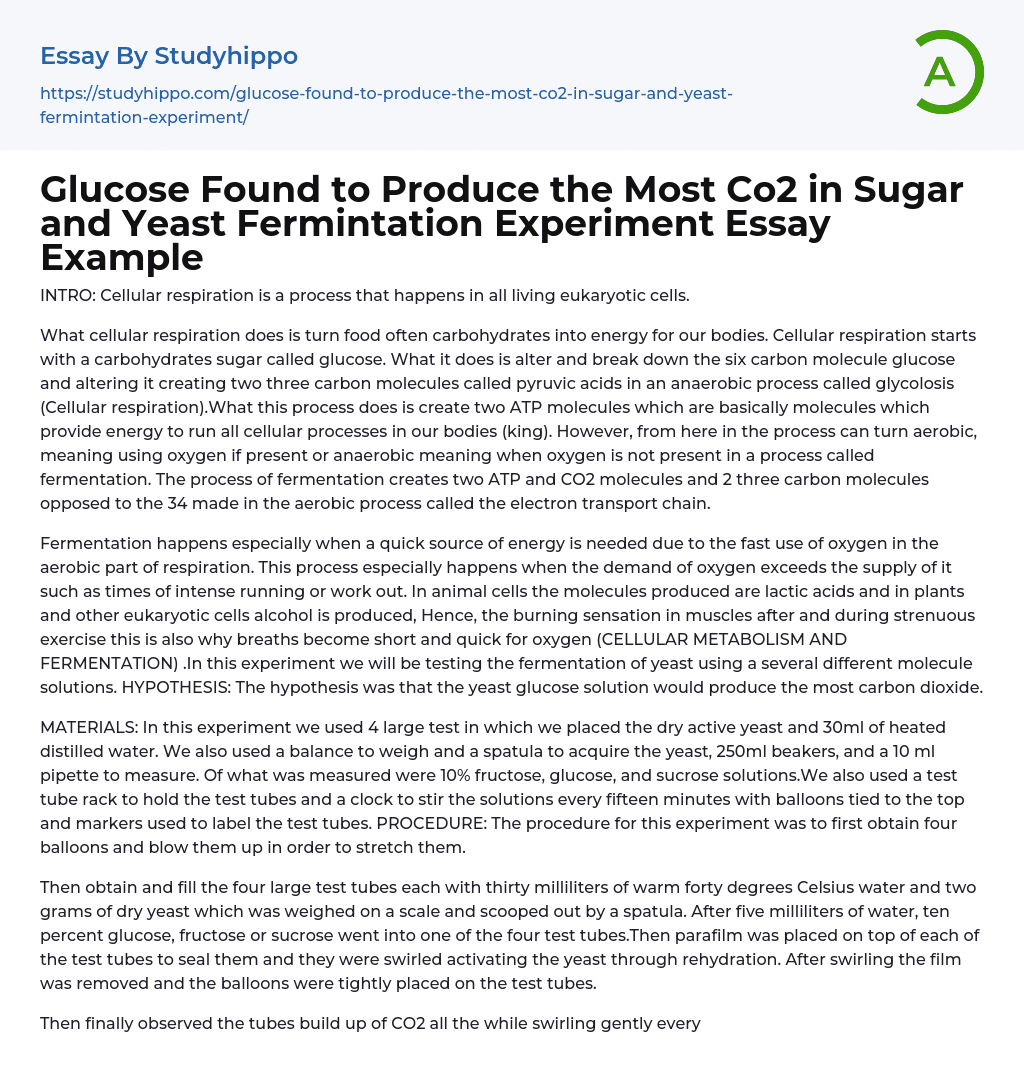

Glucose Found to Produce the Most Co2 in Sugar and Yeast Fermintation Experiment Essay Example
INTRO: Cellular respiration is a process that happens in all living eukaryotic cells.
What cellular respiration does is turn food often carbohydrates into energy for our bodies. Cellular respiration starts with a carbohydrates sugar called glucose. What it does is alter and break down the six carbon molecule glucose and altering it creating two three carbon molecules called pyruvic acids in an anaerobic process called glycolosis (Cellular respiration).What this process does is create two ATP molecules which are basically molecules which provide energy to run all cellular processes in our bodies (king). However, from here in the process can turn aerobic, meaning using oxygen if present or anaerobic meaning when oxygen is not present in a process called fermentation. The process of fermentation creates two ATP and CO2 molecules and 2 three carbon molecules opposed to
...the 34 made in the aerobic process called the electron transport chain.
Fermentation happens especially when a quick source of energy is needed due to the fast use of oxygen in the aerobic part of respiration. This process especially happens when the demand of oxygen exceeds the supply of it such as times of intense running or work out. In animal cells the molecules produced are lactic acids and in plants and other eukaryotic cells alcohol is produced, Hence, the burning sensation in muscles after and during strenuous exercise this is also why breaths become short and quick for oxygen (CELLULAR METABOLISM AND FERMENTATION) .In this experiment we will be testing the fermentation of yeast using a several different molecule solutions. HYPOTHESIS: The hypothesis was that the yeast glucose solution would produce the most carbon dioxide.
MATERIALS: In this experiment
we used 4 large test in which we placed the dry active yeast and 30ml of heated distilled water. We also used a balance to weigh and a spatula to acquire the yeast, 250ml beakers, and a 10 ml pipette to measure. Of what was measured were 10% fructose, glucose, and sucrose solutions.We also used a test tube rack to hold the test tubes and a clock to stir the solutions every fifteen minutes with balloons tied to the top and markers used to label the test tubes. PROCEDURE: The procedure for this experiment was to first obtain four balloons and blow them up in order to stretch them.
Then obtain and fill the four large test tubes each with thirty milliliters of warm forty degrees Celsius water and two grams of dry yeast which was weighed on a scale and scooped out by a spatula. After five milliliters of water, ten percent glucose, fructose or sucrose went into one of the four test tubes.Then parafilm was placed on top of each of the test tubes to seal them and they were swirled activating the yeast through rehydration. After swirling the film was removed and the balloons were tightly placed on the test tubes.
Then finally observed the tubes build up of CO2 all the while swirling gently every fifteen minutes, recording observations. RESULTS: End of Experiment All values on graph are just shown by height representing amount ignore the y-axis numbers, water having no CO2, glucose having the most, sucrose second most and fructose the least.Fifteen Minutes into Experiment Test tubeSubstrateCO2 Produced 1Waterleast 2GlucoseMost 3SucroseLast 4fructoseMiddle End Test tube Substrate CO2 Produced 1WaterNone 2GlucoseMost
3Sucrose Middle 4FructoseLeast DISCUSSION: At the end of our experiment sucrose was actually the winner of the most carbon dioxide however; DR. Sommers informed us that this was because the reaction of the glucose solution with the yeast had caused many CO2 bubbles to block up the rim not letting the gas fill up the balloon.The balloon was forgotten to blow up the balloons but luckily were still able to get pretty good results.
The reason we believed glucose to be the most is because that is what is most commonly used in cellular respiration. Water which does not even have carbon in it of course was the least producing none. Fructose even though starting off strong had the least of the sugar solution most likely due to it being still a carbon sugar but less commonly used in cellular fermentation Sucrose had the second most because it is a combination of glucose and fructose.Our results helped supporting that glucose produces the most CO2 in cellular fermentation (CELLULAR METABOLISM AND FERMENTATION). REFRENCES: Works Cited "CELLULAR METABOLISM AND FERMENTATION.
" <http://www. emc. maricopa. edu/faculty/farabee/biobk/biobookglyc. html>.
"Cellular Respiration. " 5 Mar. 2008. <http://users.
rcn. com/jkimball. ma. ultranet/biologypages/c/cellularrespiration.
html>. King, Michael W. "The Individual Reactions of Glycolysis. " IU School of Medicine.
18 Aug. 2008 <http://themedicalbiochemistrypage. org/glycolysis. html>.
- Organic Chemistry essays
- Acid essays
- Calcium essays
- Chemical Bond essays
- Chemical Reaction essays
- Chromatography essays
- Ethanol essays
- Hydrogen essays
- Periodic Table essays
- Titration essays
- Chemical reactions essays
- Osmosis essays
- Carbohydrate essays
- Carbon essays
- Ph essays
- Diffusion essays
- Copper essays
- Salt essays
- Concentration essays
- Sodium essays
- Distillation essays
- Amylase essays
- Magnesium essays
- Acid Rain essays
- Agriculture essays
- Albert einstein essays
- Animals essays
- Archaeology essays
- Bear essays
- Biology essays
- Birds essays
- Butterfly essays
- Cat essays
- Charles Darwin essays
- Chemistry essays
- Dinosaur essays
- Discovery essays
- Dolphin essays
- Elephant essays
- Eli Whitney essays
- Environmental Science essays
- Evolution essays
- Fish essays
- Genetics essays
- Horse essays
- Human Evolution essays
- Isaac Newton essays
- Journal essays
- Linguistics essays
- Lion essays



